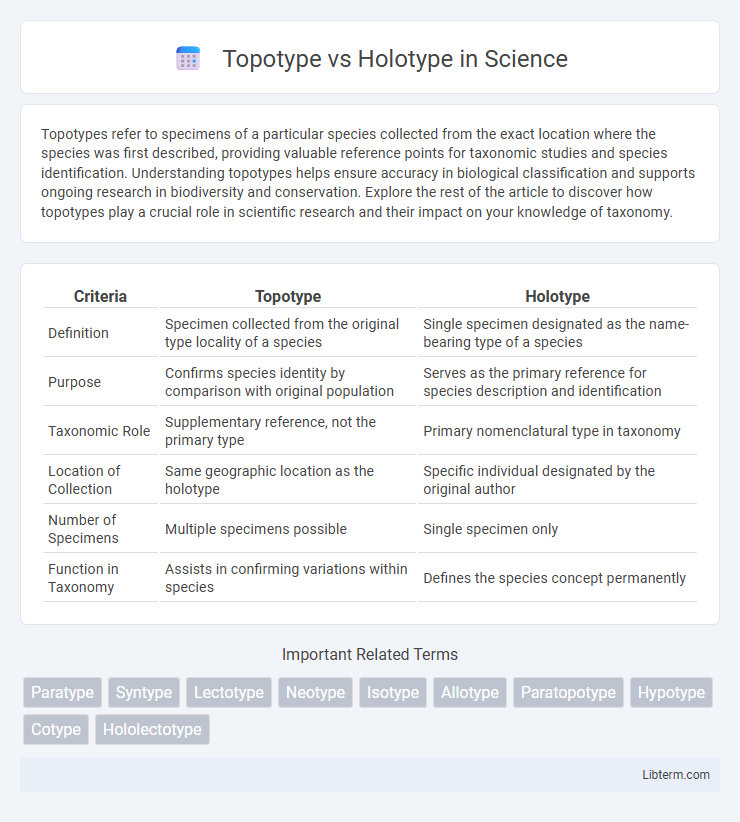Topotypes refer to specimens of a particular species collected from the exact location where the species was first described, providing valuable reference points for taxonomic studies and species identification. Understanding topotypes helps ensure accuracy in biological classification and supports ongoing research in biodiversity and conservation. Explore the rest of the article to discover how topotypes play a crucial role in scientific research and their impact on your knowledge of taxonomy.
Table of Comparison
| Criteria | Topotype | Holotype |
|---|---|---|
| Definition | Specimen collected from the original type locality of a species | Single specimen designated as the name-bearing type of a species |
| Purpose | Confirms species identity by comparison with original population | Serves as the primary reference for species description and identification |
| Taxonomic Role | Supplementary reference, not the primary type | Primary nomenclatural type in taxonomy |
| Location of Collection | Same geographic location as the holotype | Specific individual designated by the original author |
| Number of Specimens | Multiple specimens possible | Single specimen only |
| Function in Taxonomy | Assists in confirming variations within species | Defines the species concept permanently |
Introduction to Biological Classification
Holotypes serve as the single physical specimen designated as the standard bearer for a newly described species, forming a critical foundation in biological classification by providing a definitive reference point for species identification. Topotypes are specimens collected from the same locality as the holotype, used to confirm the consistency and variation within the species, enhancing accuracy in taxonomic studies. Both holotypes and topotypes play essential roles in maintaining precision and reliability in the classification and naming of biological organisms.
Defining Holotype in Taxonomy
The holotype is the single physical specimen designated by the original describer of a species to serve as the definitive example for that species' identification and classification in taxonomy. It provides an essential reference point for taxonomic verification, helping to resolve ambiguities in species delimitation. In contrast, a topotype is a specimen collected from the same location as the holotype but not necessarily the primary reference used in the species description.
Understanding Topotype: Meaning and Importance
Topotype refers to a specimen collected from the original location where the species was first described, which helps confirm and verify the species' identity through geographic consistency. Unlike the holotype, the single physical specimen designated as the species' formal reference, topotypes provide supplementary data for understanding variation within the species' native habitat. Utilizing topotypes enhances taxonomic accuracy, supports biodiversity studies, and aids conservation efforts by linking population traits directly to the type locality.
Key Differences Between Topotype and Holotype
Topotypes are specimens collected from the same locality as the holotype, serving as reference points for studying intraspecific variation, while holotypes are the single, original specimens designated by the describing author as the name-bearing type of a species. Unlike holotypes, topotypes do not hold nomenclatural status but aid in verifying species identity and morphological consistency. Key differences include the holotype's role as the definitive taxonomic reference versus the topotype's function as supplemental material from the original type locality.
The Role of Holotype in Species Identification
The holotype serves as the single, definitive specimen upon which the description and name of a new species are based, playing a crucial role in species identification and taxonomy. It provides an authoritative reference for comparing other specimens, ensuring consistency and stability in species classification. Unlike topotypes, which are specimens collected from the same locality as the holotype, the holotype holds unique nomenclatural significance as the primary physical example of the species.
Significance of Topotype in Taxonomic Studies
Topotypes play a crucial role in taxonomic studies by providing reference specimens collected from the same geographic locality as the holotype, ensuring consistency in species identification and verification. They help clarify species boundaries and morphological variation within populations, supporting accurate classification and comparative analysis. The use of topotypes enhances taxonomic precision, especially when the holotype is rare, damaged, or incomplete.
How Scientists Designate Holotypes and Topotypes
Scientists designate holotypes as the single physical specimen upon which the description and name of a new species are formally based, typically selected during initial species identification and stored in a recognized scientific collection for reference. Topotypes are specimens collected from the same geographic location as the holotype, used to study variation within the species and confirm identification, but they do not serve as the primary reference for the species' official description. Both holotypes and topotypes are critical for taxonomic clarity, with holotypes providing the definitive species reference and topotypes supporting ongoing research and verification of species characteristics.
Case Studies: Holotype vs Topotype in Practice
Case studies comparing holotype and topotype specimens highlight the importance of precise geographic and morphological data in taxonomic classification. Holotypes serve as the definitive reference for species identification, while topotypes, collected from the same location as the holotype, provide additional genetic and phenotypic context, enhancing the accuracy of taxonomic revisions. Such comparative analysis is critical in biodiversity assessments, species conservation strategies, and resolving taxonomic ambiguities in regions with high endemism.
Challenges and Controversies in Type Specimen Selection
Challenges in selecting topotypes arise due to environmental variation and population heterogeneity, which may lead to misinterpretation of species boundaries when specimens from the exact locality differ genetically or morphologically. Holotype selection controversies often involve historical specimens lacking detailed provenance or inadequate preservation, complicating species verification and taxonomic stability. Debates persist regarding the reliance on holotypes versus topotypes for resolving taxonomic ambiguities, particularly in groups with high intraspecific variation or poorly documented type localities.
Conclusion: The Value of Topotype and Holotype in Modern Taxonomy
Topotypes provide critical geographic context by representing specimens collected from the original type locality, enhancing understanding of species variation within localized environments. Holotypes serve as the definitive reference specimen for species identification, ensuring taxonomic stability and clarity in classification. Combining the diagnostic precision of holotypes with the ecological relevance of topotypes refines modern taxonomy by supporting accurate species delineation and evolutionary studies.
Topotype Infographic

 libterm.com
libterm.com